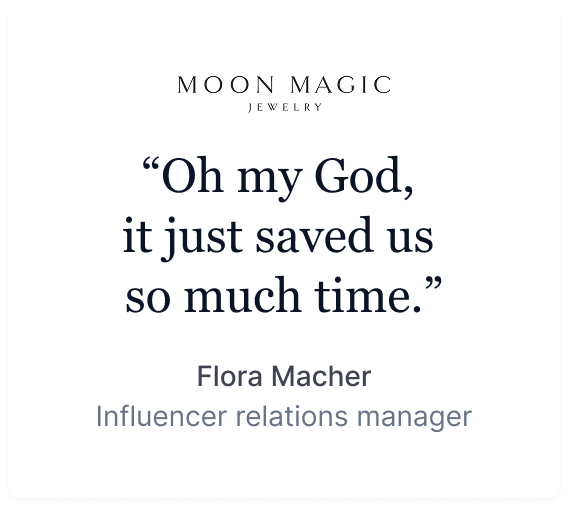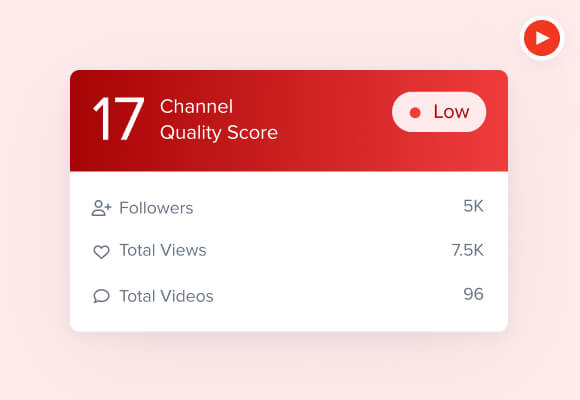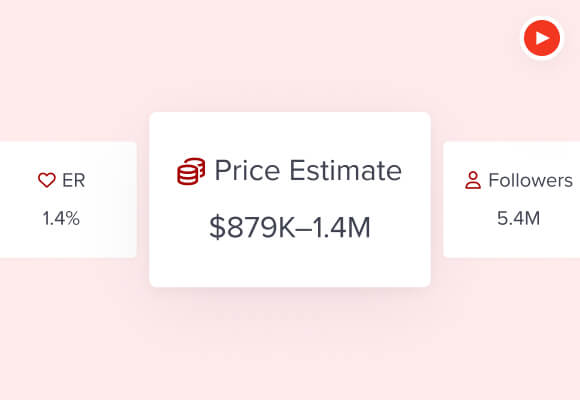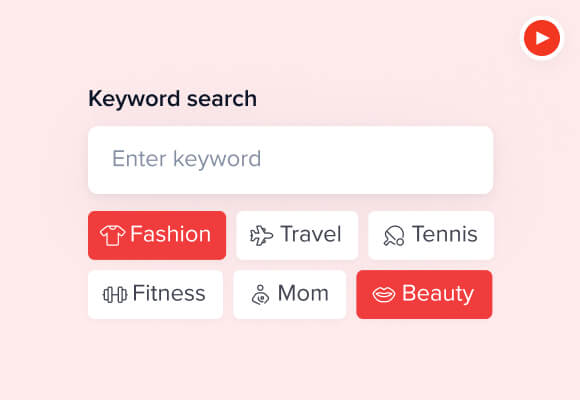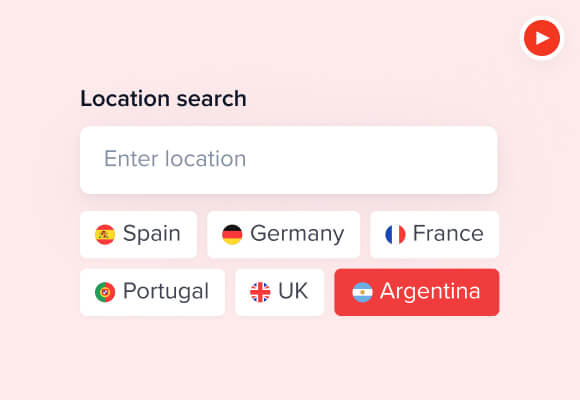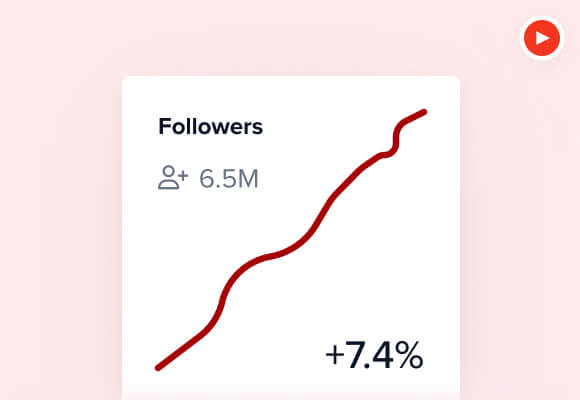Compare YouTube Channels
HypeAuditor’s goal as a leading influencer marketing app is to empower brands and agencies to compare YouTube subscribers between two accounts. With HypeAuditor’s YouTube Influencer Comparison Checker, you’re able to compare YouTube stats like followers, follower growth, and engagement rate.
HypeAuditor’s YouTube Influencer Comparison Checker is a free YouTube channel comparison tool that helps you conveniently compare YouTube stats in one place. You can even compare YouTube channels’ subscribers to discover how they overlap (allowing you to maximize your reach or double down on a specific audience demographic). Eliminating YouTube influencers with small audiences, low growth, and poor engagement rates is also made easier with our free influencer comparison checker. You’ll enjoy more value from influencer collaborations while optimizing your influencer marketing budget with our free comparison tool.
Compare Youtube Channels Questions
What does HypeAuditor’s YouTube Influencer Comparison Checker do?
HypeAuditor’s YouTube Influencer Comparison Checker allows you to compare two different YouTube content creators side by side and see how their engagement rate, subscribers, and subscriber growth in 30 days stack up to each other.
Why is it important to compare channels?
If you want to make sure your marketing budget is spent wisely, it’s important for you to compare YouTube channels. Doing so might and finding a similar channel will even help you uncover a better deal.
Imagine this scenario: Two YouTube influencers have the same values for subscribers, engagement, and growth. However, Influencer A demands $2,000 for a collaboration while Influencer B demands $1,000. Assuming that Influencer A isn’t a celebrity who can provide extra value simply through association and name recognition, there’s no clear reason to spend your limited marketing budget on Influencer A. Not only are you more likely to get similar results at half the price with Influencer B, but you can commit the remaining $1,000 for a second collaboration with Influencer B (assuming they do well), or you can use the savings for some other purpose.
Why is engagement rate important?
Engagement rate provides insight into how often a channel’s audience interacts with a YouTuber’s videos. High engagement rates suggest that the channel publishes engaging, good-quality videos. Low suggest rates suggest the opposite – that a channel publishes uninteresting, unengaging content.
You want to look for channels with high engagement rates because it increases the likelihood of sales or conversions during channel collaborations. And the more sales and conversions you get, the lower the cost per sale or conversion. As a result, your marketing spend is used more efficiently.
Why should I look at the number of subscribers?
Although it’s not the best influencer metric, tracking the subscriber counts of YouTube accounts is useful for quickly eliminating some influencer from consideration.
Generally, YouTube channels with large numbers of subscribers are more attractive for potential collaborations. This is because a large audience represents more opportunities for potential sales or conversions. As a result, you can set a floor for the minimum number of subscribers needed and eliminate all YouTube creators and channels with subscriber counts below the established floor.
In addition to more opportunities for sales and revenue, there are several reasons why YouTube channels try to grow their subscriber count:
- More subscribers can lead to more engagement (and a more active audience)
- Bigger subscriber counts suggest the channel is more reliable, engaging, or trustworthy
- Number bias (big numbers seem more impressive, which results in greater likelihood of possible collaboration)
Tools that track subscriber counts in real time can make it quicker and easier to collect data and filter out YouTube channels that don’t meet your criteria.
Why is it important to check subscriber growth?
At its core, subscriber count is a vanity metric that measures a single moment in time. As a result, the subscriber count is limited in its value and application. The only conclusion that can be justified by subscriber counts is that a YouTube channel has a small or large audience. Thus, the only decision that subscriber count can enable is the filtering of influencers who are too small or too big to work with.
Other metrics are more effective at helping determine who to work with. Subscriber growth is an example of such a metric.
Strong, positive subscriber growth indicates that a YouTube channel is producing good quality content in an interesting and engaging manner. Consequently, collaborations with a good YouTube channel are more likely to prove successful.
The inverse is also true. YouTube channels with weak, negative subscriber growth are unlikely to prove successful at achieving the goals of a collaboration. Negative growth suggests that the channel is producing uninteresting content that is driving viewers away. There may be other reasons for a YouTube channel to have negative growth, but in most cases, a sustained period of negative growth is an indicator to refrain from collaborations.
It’s important to remember that subscriber growth is not a bulletproof metric. Seasonal fluctuations do occur, and they can cause channels to naturally experience positive or negative growth. For instance, channels that focus on vacations in Greece are likely to experience strong, positive subscriber growth during the buildup to summer vacation. At the same time, channels that specialize in content about snowboarding may have a contraction in subscribers during summer before rebounding in the months leading up to winter.
What are some “red flags” when looking for a channel?
The first red flag you should look for is fake subscribers. YouTube channels are incentivized to chase the biggest number of subscribers they can get, which means some bad or malicious actors may decide to inflate their subscriber count by purchasing fake subscribers.
But before you avoid working with a YouTube channel due to the presence of fake subscribers, don’t consider fake subscribers in a “vacuum”. Every YouTube channel has some number of bots or fake subscribers following them. To control for the presence of bots and fake subscribers, you should look at the percentage of the audience who is comprised of bots and fake subscribers.
Some other major red flags for a YouTube channel include:
- Sustained negative subscriber growth – This indicates that a channel has been producing poor content over several months.
- No personal brand – If you’re not sure what a YouTube channel is about, then it’s likely that viewers also don’t know what the channel is about.
- Low engagement rate – Even if a channel has 1 million subscribers, if a channel has a low engagement rate, this means that the chance of conversions is low.
- Low Channel Quality Score – The name of the metric speaks for itself. If a channel has a low quality score, then that means the channel is of low quality.
Another factor you should consider is the channel’s posting frequency. Successful YouTube channels post videos on a consistent basis, such as every day, every other day, or once every week.
What should I look for in a channel?
If you’re searching for a data-driven approach for finding a standout YouTube channel, then YouTube statistics like subscribers, subscriber growth, engagement rate, and CQS can help you make numbers-based marketing decisions. These aren’t the only YouTube KPIs for powering smarter influencer marketing choices. If you find a good channel comparison tool, it will be much simpler to compare and contract the YouTube subscriber counts of two channels.
Remember that not all YouTube metrics are created equal. Some metrics are good for a first impression or filter (such as subscribers). Some metrics are more useful for projecting potential success (such as engagement rate, CQS, and earned media value).
